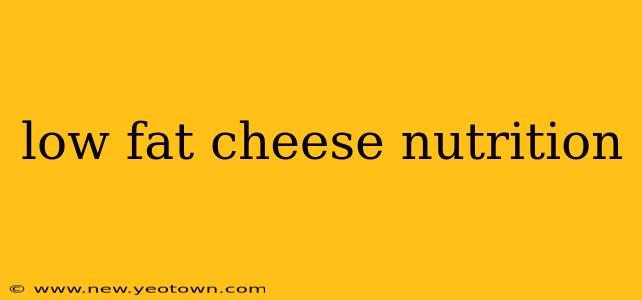Cheese, oh glorious cheese! That creamy, tangy, sometimes sharp delight that graces our pizzas, salads, and sandwiches. But for those watching their fat intake, the creamy goodness can feel like a forbidden pleasure. Fear not, cheese lovers! This isn't a tale of deprivation, but a journey into the world of low-fat cheese, exploring its nutritional profile and answering your burning questions.
Imagine this: you're enjoying a delicious grilled cheese sandwich, the warmth spreading through you, the satisfying chew of the bread…but without the guilt. That's the promise of low-fat cheese. It allows you to enjoy the taste and texture you crave while managing your dietary fat intake. Let's delve into the details.
What are the nutritional benefits of low-fat cheese?
Low-fat cheese offers a surprising array of nutritional benefits. While it's lower in fat compared to its full-fat counterparts, it still provides essential nutrients like protein and calcium, crucial for building and maintaining strong bones and muscles. It's also a good source of various vitamins and minerals, though the exact quantities vary depending on the type of cheese. Think of it as a delicious compromise: you get the cheesy goodness with a healthier fat profile.
How does low-fat cheese compare to full-fat cheese nutritionally?
The primary difference lies in the fat content. Full-fat cheese typically boasts a higher percentage of fat, leading to a more decadent texture and richer flavor. However, this also means a significantly higher calorie count. Low-fat cheese, on the other hand, reduces the fat content, resulting in fewer calories and a slightly different taste and texture. It’s not a dramatic shift, but a noticeable one for the discerning palate. The nutritional differences extend beyond just fat; the levels of certain vitamins and minerals can fluctuate slightly.
Is low-fat cheese good for weight loss?
This is a common question, and the answer is nuanced. Low-fat cheese can certainly be part of a healthy weight-loss diet because of its reduced calorie and fat content. However, weight loss is a multifaceted process that involves a balanced diet and regular exercise. While swapping full-fat cheese for its low-fat counterpart can contribute to a calorie deficit, it's not a magic bullet. Portion control remains key.
What are the different types of low-fat cheese?
The world of low-fat cheese is surprisingly diverse! You'll find various types, ranging from mild cheddar and mozzarella to sharper varieties like Colby Jack. Many brands offer reduced-fat versions of your favorite cheeses, so exploring your local grocery store is a great starting point. Remember to check the nutrition labels to compare fat content and other nutritional information.
Does low-fat cheese taste different from full-fat cheese?
Yes, there's a noticeable difference in taste and texture. Low-fat cheese often has a slightly less rich and creamy flavor, and the texture might be somewhat less smooth. However, advancements in cheese-making have significantly reduced this difference. Many low-fat cheeses offer a surprisingly satisfying taste and texture, making the switch a relatively easy one for most people.
Are there any downsides to eating low-fat cheese?
While generally beneficial, there are minor potential downsides. The manufacturing process of low-fat cheese sometimes involves altering the original texture and taste. Some individuals find the taste less appealing compared to full-fat varieties. Also, be mindful of added ingredients like sodium, which can be higher in some low-fat cheeses. Always check the nutrition label!
Conclusion
Low-fat cheese is a fantastic alternative for those seeking a healthier approach to enjoying cheese without sacrificing flavor entirely. By understanding its nutritional benefits and making informed choices, you can incorporate this versatile dairy product into your diet, enjoying all the deliciousness with a touch more health consciousness. So, go ahead, indulge responsibly! Your taste buds (and waistline) will thank you.

